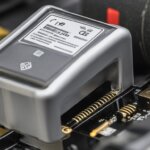Table of Contents
Radio Frequency Identification (RFID) technology has revolutionized various industries by utilizing electromagnetic fields to track and identify objects. Unlike traditional barcodes, RFID tags do not require direct visibility and can be embedded within the objects themselves.
RFID systems consist of RFID tags, RFID readers, and antennas. By using electromagnetic waves, RFID tags communicate with the RFID readers, enabling the collection and transmission of data. There are several types of RFID systems, including Active, Passive, and Semi-Passive, each with its own unique features and applications.
RFID systems operate at different frequencies, such as Low Frequency (LF), High Frequency (HF), Ultra-High Frequency (UHF), and Microwave Frequency, offering various capabilities and ranges for different use cases.
RFID technology plays a critical role in industries like supply chain management, retail, and healthcare. It enables real-time visibility of goods movement, accurate inventory management, and efficient tracking of shipments. In the retail sector, RFID tags enhance inventory management, facilitating faster and more accurate stocktaking. In healthcare, RFID technology is utilized to track medical equipment, medication, and patients, improving safety and operational efficiency.
In this comprehensive guide, we will delve deeper into RFID mechanics, types of RFID systems, applications in different industries, and a comparison between RFID, barcodes, and Near Field Communication (NFC). Stay tuned to uncover the full potential of RFID technology in the modern world.
Understanding RFID Mechanics
In this section, we will delve into the fundamental mechanics of RFID technology, exploring the crucial components that enable its functionality. By understanding the core elements of RFID systems, including RFID tags, RFID readers, and antennas, we can gain insight into how this technology facilitates seamless identification and tracking processes.
RFID Tags
At the heart of the RFID system are RFID tags, which are compact devices equipped with a chip and an antenna. These tags securely store data relating to the item or object being monitored. The chip acts as the data repository, holding critical information, while the antenna enables communication between the tag and the RFID reader.
RFID Readers
To facilitate the transmission of data, RFID readers play a vital role. These devices emit electromagnetic waves, creating an RFID field. When an RFID tag enters this field, it activates the tag, prompting it to transmit its stored information to the reader. Essentially, the reader acts as the receiver, capturing the transmitted data from the activated tag.
Antennas
An integral component of any RFID system is the antenna. Acting as the intermediary between the RFID tag and the reader, the antenna facilitates efficient data acquisition and communication. Through the antenna, the RFID tag’s data is transmitted to the reader, ensuring accurate and reliable information transfer.
RFID systems operate at various frequencies, providing flexibility and versatility. The choice of frequency determines factors such as the range of operation and data transfer rates. By selecting the appropriate frequency for a specific application, RFID systems can be tailored to meet different requirements.
Now that we have explored the mechanics of RFID technology, we will move on to the next section, where we’ll examine the different types of RFID systems and their respective applications.
| RFID Component | Description |
|---|---|
| RFID Tags | Small devices containing a chip and an antenna that store data about tracked items |
| RFID Readers | Devices that emit electromagnetic waves to activate RFID tags and capture transmitted data |
| Antennas | Facilitate data acquisition and communication between RFID tags and readers |
Types of RFID Systems
RFID systems play a crucial role in various industries, offering efficient tracking and identification capabilities for a wide range of applications. These systems can be classified into three main types based on their power supply and operational mechanisms: Active RFID systems, Passive RFID systems, and Semi-Passive RFID systems. Each type has its own distinct features and advantages.
Active RFID Systems
Active RFID systems are equipped with their own power source, typically in the form of a battery. This enables them to provide long read ranges, making them suitable for applications that require tracking objects over large distances. Active RFID systems also offer larger data storage capacities, allowing for the storage of additional information such as temperature sensing data. These systems are commonly used in asset tracking, vehicle tracking, and real-time inventory management.
Passive RFID Systems
Passive RFID systems, on the other hand, rely on the power provided by the RFID reader for their operation. They do not have their own power supply or battery. As a result, passive RFID tags are typically smaller and more cost-effective compared to active tags. Despite their smaller form factor, passive RFID systems offer an unlimited lifespan. These systems are commonly used in applications such as access control, supply chain management, and retail inventory tracking.
Semi-Passive RFID Systems
Semi-Passive RFID systems, also known as battery-assisted passive (BAP) systems, combine features of both active and passive systems. These systems have a battery that powers the RFID chip, which helps extend the read range beyond what passive systems can achieve. Semi-Passive RFID systems are commonly used in applications that require a moderate read range and longer battery life, such as logistics and outdoor asset tracking.
All RFID systems operate at specific frequencies, each with its own set of characteristics and applications. The commonly used RFID frequencies include:
- Low Frequency (LF) – typically operates in the range of 125 kHz to 134 kHz, suitable for short-range applications and environments with high interference.
- High Frequency (HF) – typically operates in the range of 13.56 MHz, suitable for applications that require moderate read ranges and data transfer rates.
- Ultra-High Frequency (UHF) – typically operates in the range of 860 MHz to 960 MHz, suitable for long-range applications, such as supply chain management and inventory tracking.
- Microwave Frequency – operates in the range of 2.45 GHz, suitable for applications that require high data transfer rates and short-range communication.
Here is a comparison table highlighting the key features and applications of Active RFID systems, Passive RFID systems, and Semi-Passive RFID systems:
| RFID System | Power Source | Read Range | Data Storage Capacity | Additional Features | Ideal Applications |
|---|---|---|---|---|---|
| Active RFID Systems | Battery | Long | High | Temperature Sensing | Asset Tracking, Vehicle Tracking, Real-time Inventory Management |
| Passive RFID Systems | Reader’s Power | Short to Moderate | Low | N/A | Access Control, Supply Chain Management, Retail Inventory Tracking |
| Semi-Passive RFID Systems | Battery (for Chip) | Moderate to Long | Medium | N/A | Logistics, Outdoor Asset Tracking |
By understanding the different types of RFID systems and their associated frequencies, businesses can choose the most suitable solution to meet their specific needs and optimize their operations.

Applications of RFID Technology
RFID technology has revolutionized various industries with its wide range of applications. From supply chain management to retail and healthcare, RFID has proven to be a valuable asset in optimizing operations and improving efficiency.
Supply Chain Management
In the field of supply chain management, RFID plays a crucial role in providing real-time visibility into the movement of goods. By utilizing RFID tags embedded in products or packaging, companies can accurately track inventory, monitor shipments, and streamline logistics processes. This level of visibility enables proactive inventory management, reduces stockouts, and enhances the overall efficiency of the supply chain.
Retail
RFID technology has transformed the retail sector by revolutionizing inventory management. With RFID tags attached to individual items, retailers can automate stocktaking processes, helping them maintain up-to-date inventory records with greater accuracy and speed. This enables faster replenishment, reduces out-of-stock situations, and enhances the overall customer experience.
Healthcare
In healthcare, RFID technology plays a vital role in improving patient safety and operational efficiency. RFID tags are used to track medical equipment, ensuring that the right tools are available when needed, reducing the risk of errors and delays. Medication tracking through RFID helps prevent medication errors and enhances inventory management. Additionally, RFID-enabled patient tracking systems ensure accurate identification and improve patient flow within healthcare facilities.
Other Applications:
- Access Control Systems: RFID technology is used in access control systems for secure and efficient entry management.
- Document Tracking: RFID tags enable the tracking and management of important documents, ensuring efficient document retrieval and improved workflow.
- Race Timing: In sports events, RFID technology is used for accurate and automated race timing, providing real-time results and enhancing the overall experience for participants and spectators.
RFID technology continues to find new applications across industries, driven by its ability to enhance visibility, improve operational efficiency, and enable real-time data capture. With advancements in technology and increasing adoption, the potential for RFID to transform various sectors remains vast.
| Industry | RFID Application |
|---|---|
| Supply Chain Management | Real-time inventory management and shipment tracking |
| Retail | Automated stocktaking and inventory management |
| Healthcare | Medical equipment and medication tracking, patient identification |
| Access Control Systems | Secure and efficient entry management |
| Document Tracking | Efficient document retrieval and workflow management |
| Race Timing | Accurate and automated race timing |
RFID vs. Barcodes and NFC
RFID technology offers several advantages over traditional barcodes. Unlike barcodes, RFID tags do not require direct line of sight for identification. This means that RFID tags can be read even when they are not visible or obstructed, making them more versatile and efficient in various industries. Additionally, RFID tags support real-time data updating, allowing for accurate and up-to-date information about tracked objects.
However, RFID technology does come with its own set of challenges. Reader collision and tag collision are common issues in RFID systems, where multiple readers or tags interfere with each other. To mitigate these challenges, anti-collision protocols are implemented to ensure smooth and accurate data communication. Furthermore, RFID security and privacy are important considerations. Due to the wireless nature of RFID, unauthorized readers can potentially access the information on RFID tags, leading to security breaches. Safeguarding RFID systems against unauthorized access is crucial to protect sensitive data.
It is also important to differentiate RFID from NFC technology. While RFID technology enables communication between tags and readers over longer distances, NFC (Near Field Communication) allows for communication between devices at close range, typically up to a few centimeters. NFC combines the functionalities of a smart card and a reader into a single device, enabling bi-directional communication and secure interactions between devices.
FAQ
What is RFID technology?
RFID, which stands for radio-frequency identification, is a transformative technology that uses electromagnetic fields to identify and track objects through the use of tags.
What are the basic components of an RFID system?
An RFID system consists of RFID tags, RFID readers, and antennas.
What types of RFID systems are there?
There are three types of RFID systems: Active, Passive, and Semi-Passive, each with its own unique features and applications.
What frequencies do RFID systems operate at?
RFID systems operate at different frequencies, including Low Frequency (LF), High Frequency (HF), Ultra-High Frequency (UHF), and Microwave Frequency.
Where is RFID technology applied?
RFID technology is applied in various industries, such as supply chain management, retail, and healthcare.
How do RFID systems work?
RFID systems work by using RFID tags, RFID readers, and antennas to transmit and receive data between objects.
How does RFID differ from barcodes and NFC?
RFID offers advantages over traditional barcodes, such as the ability to identify objects without direct line of sight and real-time data updating. NFC, on the other hand, enables communication between devices at close range.
What are the challenges and concerns with RFID technology?
RFID has challenges like reader collision and tag collision, but these can be mitigated through anti-collision protocols. RFID security and privacy are concerns, as RFID tags can be read by unauthorized readers, leading to potential data breaches.







